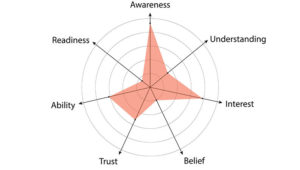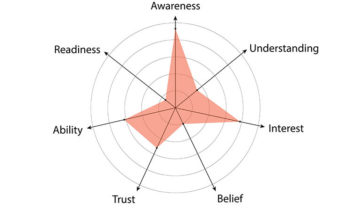First is Best
Narrowcast Rather Than Broadcast
 One might argue that Tom conflates marketing automation, inbound marketing, and content marketing. However, I hear something different. What I understand from Tom’s comments is that he believes the intersection of these tools and techniques is too broad and too passive to be the centerpiece of business development for professional services.
One might argue that Tom conflates marketing automation, inbound marketing, and content marketing. However, I hear something different. What I understand from Tom’s comments is that he believes the intersection of these tools and techniques is too broad and too passive to be the centerpiece of business development for professional services.
Rather, Tom recommends a narrowcasting approach built on two themes:
First is Best. Define the category in which you place yourself and your firm so you can be #1. As Tom puts it, “It’s way better to be the largest full-service accounting firm serving Austin, Texas, than it is to be the 101st largest accounting firm serving North America.”
Build Targeted Relationships. Given your niche, identify the people with whom you want to develop a meaningful relationship. In professional services, the number is likely to be in the hundreds—not in the thousands or tens of thousands. Engage the community you most which to serve in conversation. Learn about their interests and demonstrate your trustworthiness.
The Role of Content Marketing and Marketing Automation

In my experience, Tom is no Luddite. His firm utilizes a modern customer relationship management system rather than a Rolodex. Neither is he opposed to content marketing. After all, he invested months into researching and writing How Clients Buy and actively develops videos, podcasts, and blog posts for this website. It’s just that Tom views these and other technologies as tools best used with intention.
Doug Fletcher and Tom argue seven elements must be satisfied before a prospective client will engage your services:
- A prospective client needs to be aware of you.
- A prospect must understand what you do and how you can help them.
- In order to have sufficient interest, your capabilities must address your prospective client’s priorities.
- A prospect must respect your work and believe you can do the job.
- A prospective client must trust that you will have their best interests at heart.
- A prospect must have the authority and ability to engage.
- The timing must be right. That is, a prospect must be ready.
Truly valuable content can help build awareness, understanding, and even belief. Timely communication that leverages marketing automation can even spark a conversation at the moment of readiness. Demonstrating trustworthiness, on the other hand, is more subtle. Emails, newsletters, and white papers are insufficient. Cultivating trust benefits immensely from real conversations and face time.
By all means, create content. Share the good stuff. Use inbound marketing and marketing automation—mindfully—to build awareness and understanding of your firm and its capabilities. Just don’t neglect the importance of relationships and trust. For that, you need to get personal. A sharpened focus will make the effort easier, more productive, and personally satisfying.
Additional Reading:
- The Seven Elements of Business Development for Professional Services
- Trust is Everything
- The Good Stuff




